
The urban-type settlement of Yantarny is considered the "capital" of the Amber region and the best resort of the Kaliningrad region.
It is in Yantarny that the only place in the world where amber is extracted on an industrial scale by an open method is located. The village is also famous for its sandy beaches and some interesting sights.
Yantarny is famous for the longest and widest sandy beach strip in the region on the Baltic Sea coast, which runs along the entire village and goes beyond it.
Two parts of the beach have been awarded the "Blue Flag" award and have all the necessary beach infrastructure - this is the "Central Beach" and the "Anna Mine" beach. More about beaches in Yantarny...
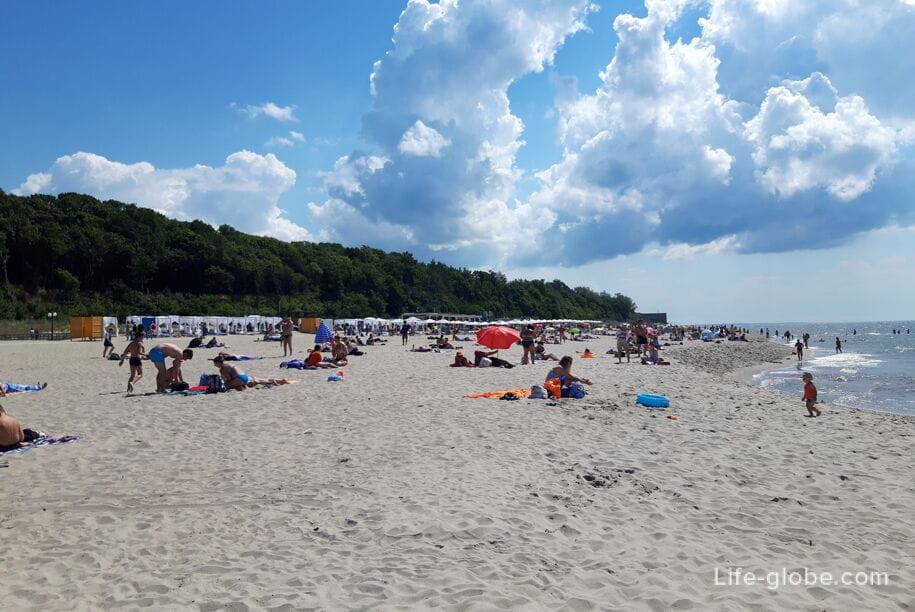
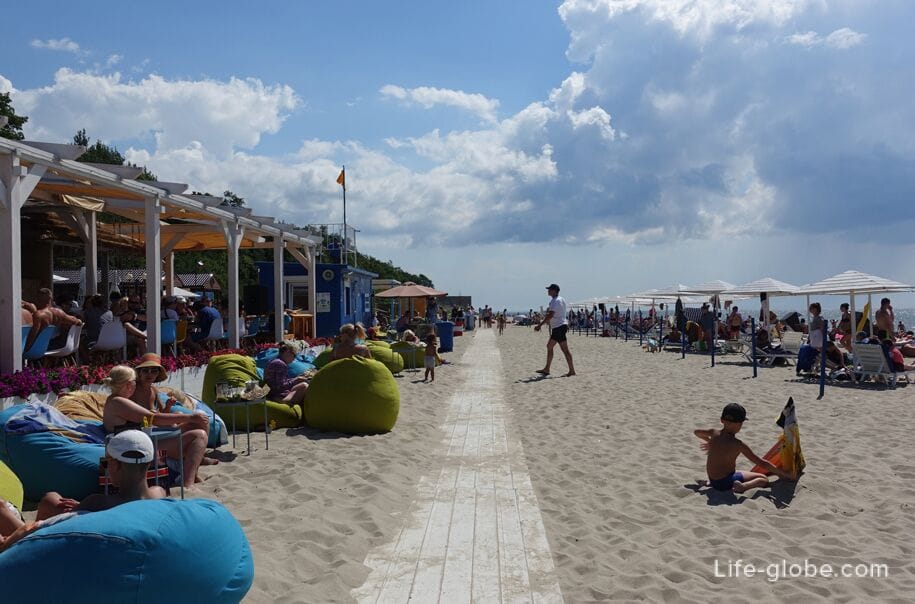
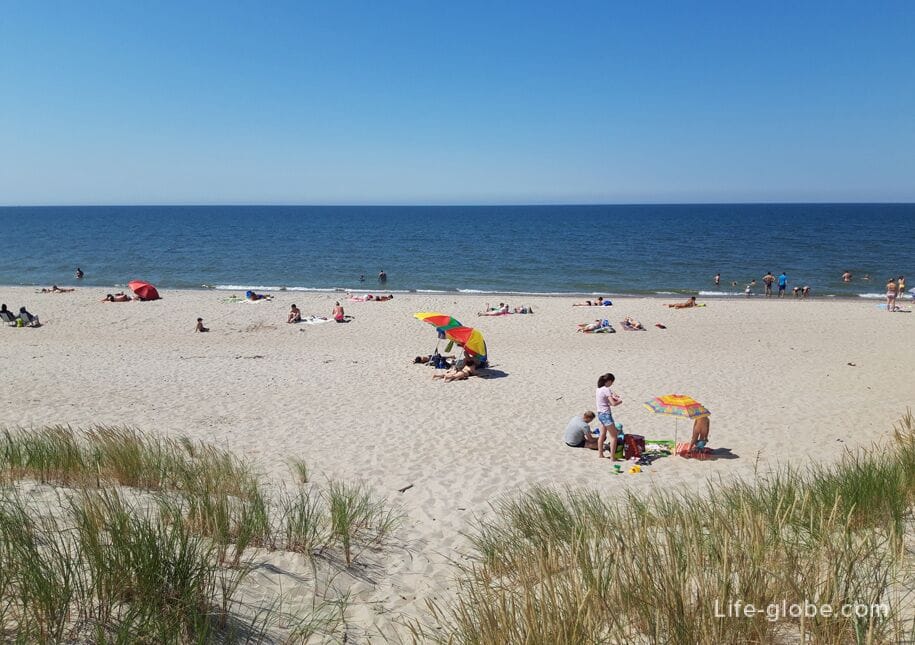
The promenade was opened in 2014 as an object of tourist infrastructure and since then has been one of the attractions and a popular place for walking and relaxing in Yantarny.
The promenade is completely pedestrian, made of Siberian larch, has wooden railings.
The length of the promenade is just under 2 kilometers. Decorative lanterns are installed on the promenade, there are places to rest and urns.
The amber promenade stretches parallel to the sea line in the south-north direction and connects the Central Beach (from the central descent to the sea from Becker Park) with the Anna Mine beach. Learn more about the promenade in Yantarny...
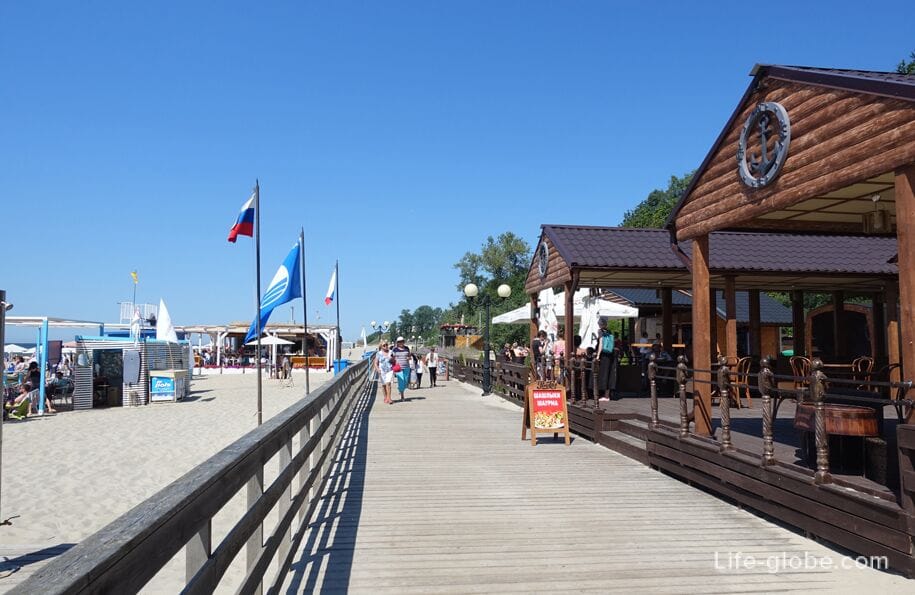
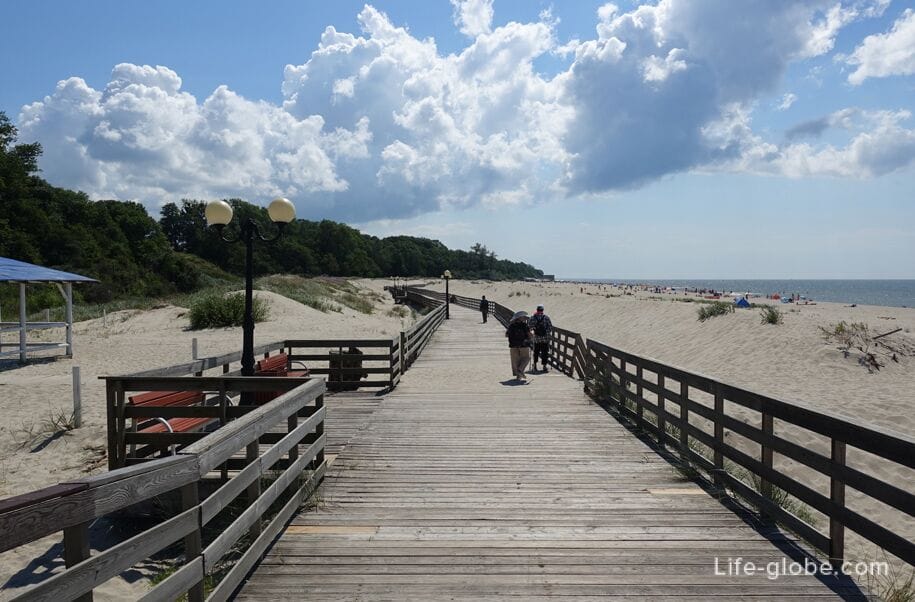
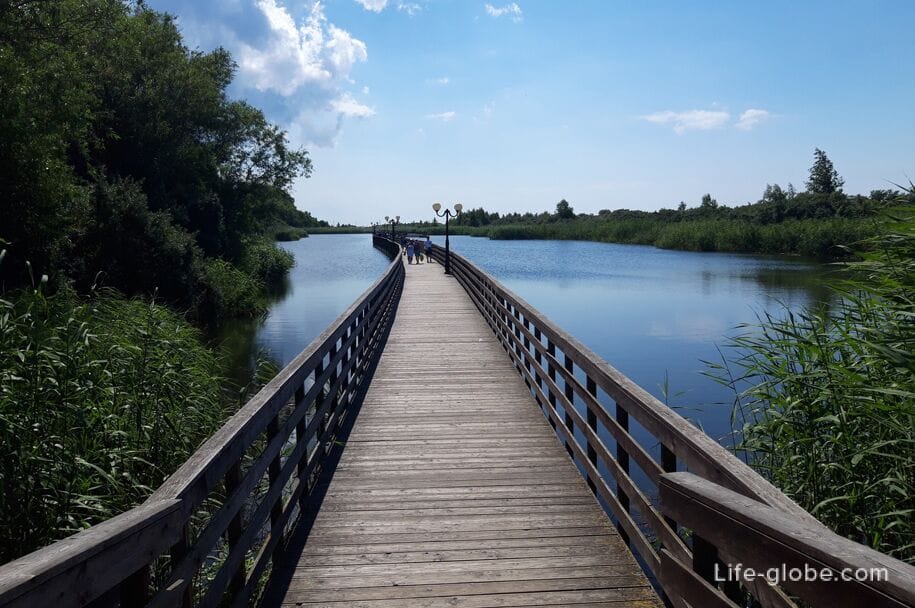
Several descents lead from the center of Yantarny to the beaches and the sea, notable for the fact that they offer panoramic views of the beach strip and sea waters.
The most interesting are the descents / ascents:
- Central descent to the sea, which leads from Becker Park (Central Alley) to the Central beach and promenade.
The descent is a wide staircase equipped with a lifting platform for people with disabilities.
The stairs offer panoramic views of the beach, the southern end of the promenade and the Baltic Sea;
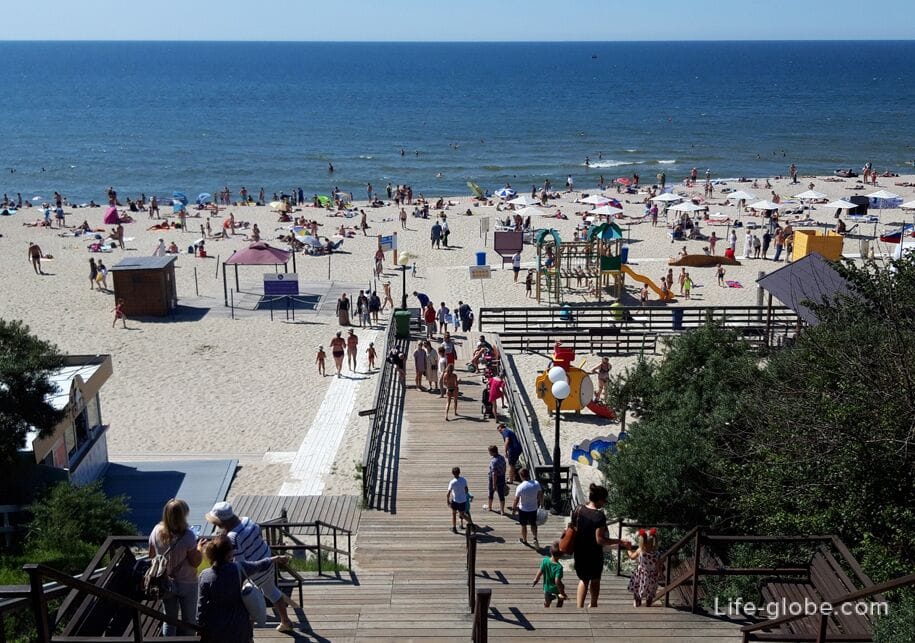
- descent in the form of a ramp that leads from Becker Park (Amber Alley) to the promenade and to the beach.
The descent platform offers views of the beach strip, the promenade and the sea.
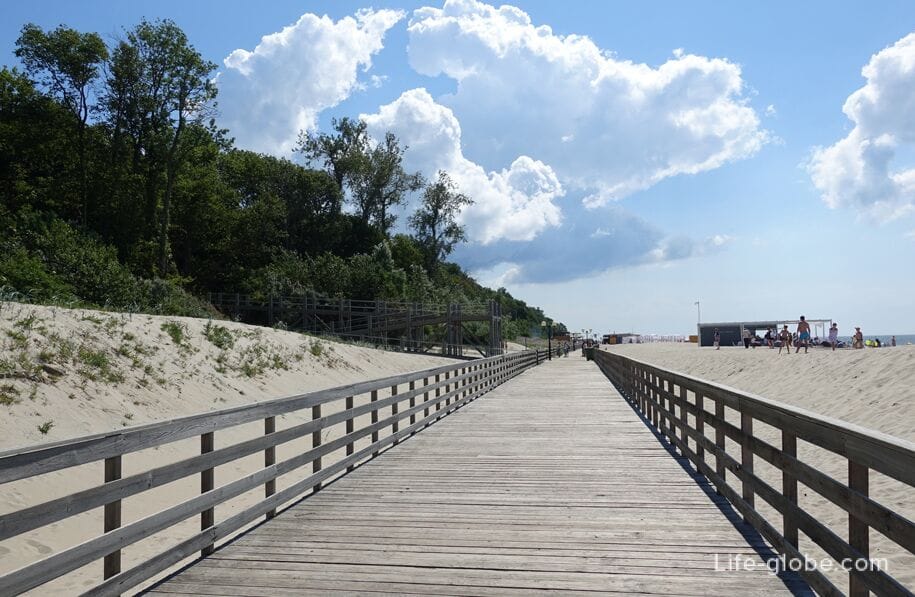


Moritz Becker Park is a city park that is a historical monument and the pearl of Amber.
The park is located in the center of Amber, on an elevated terrace near the Baltic Sea and the Central Beach.
In Becker Park, notable:
- alleys running through the park;
- rare plants and trees;
- a memorial sign to the founder of the park - Moritz Becker;
- rotunda;
- literary and amber trail (Coastal Alley), along the eastern side of which stands with profiles of famous poets and poetesses and excerpts from their works are installed;
- the Museum of the Baltic Sea Countries, which is an open-air museum, whose sculptures, located near the alleys of Becker Park (central, coastal and middle), with the help of mythical creatures or heroes of national fairy tales, tell about the environmental problems of the Baltic Sea;
- view swings installed on a wooden platform above the cliff of the park in such a way that when swinging on them, views of the beach and the Baltic Sea open up;
- wooden figures, amber fairs and cafes. More about Becker Park...
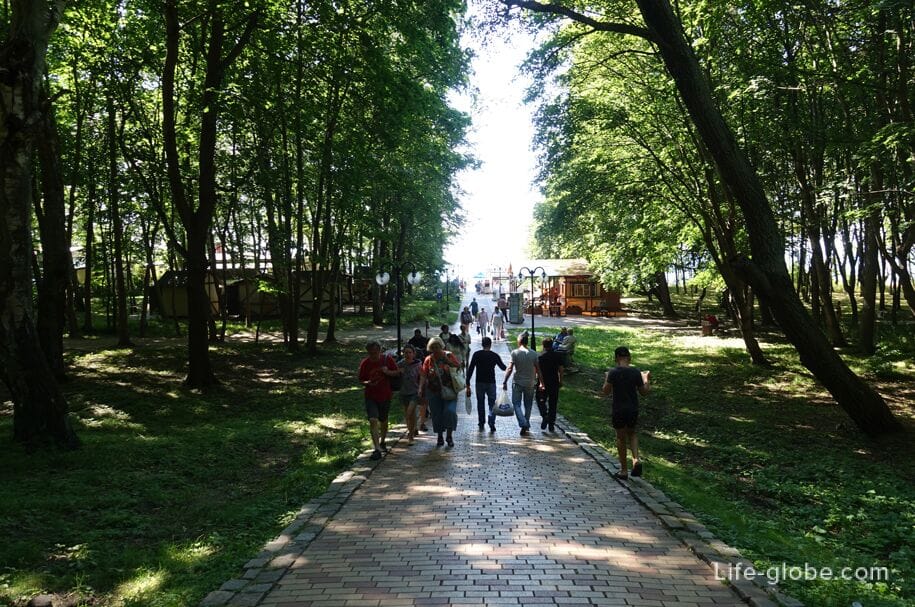
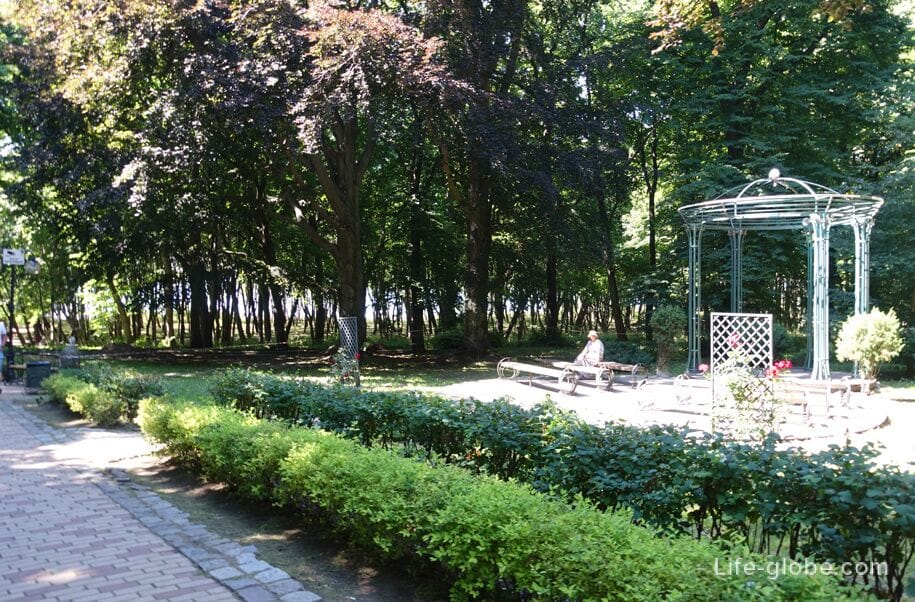
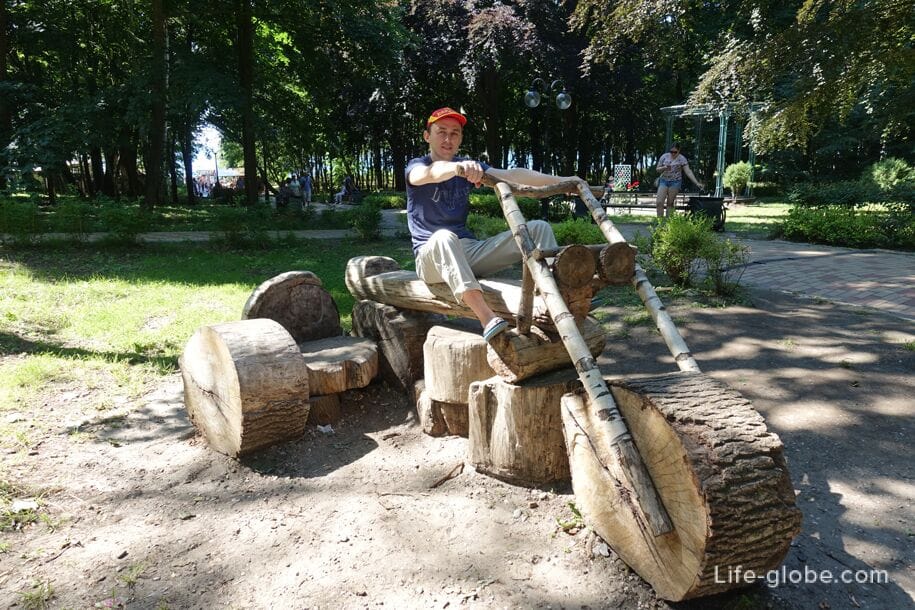
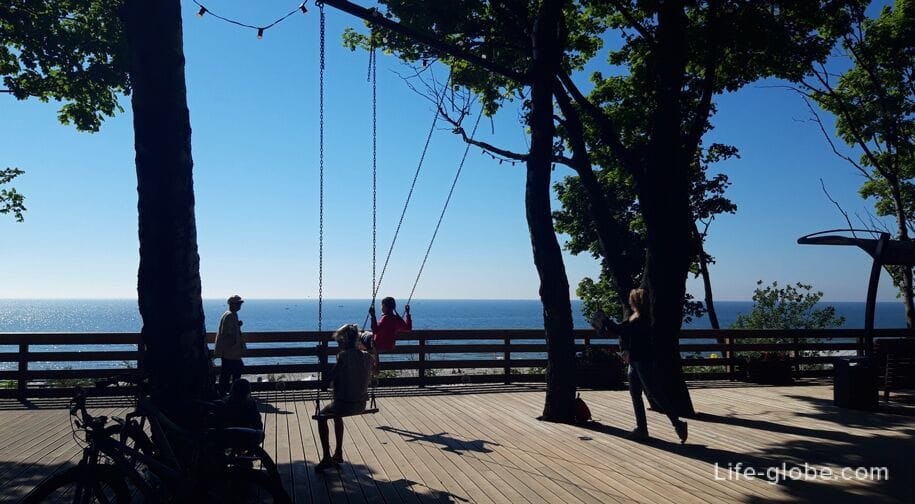
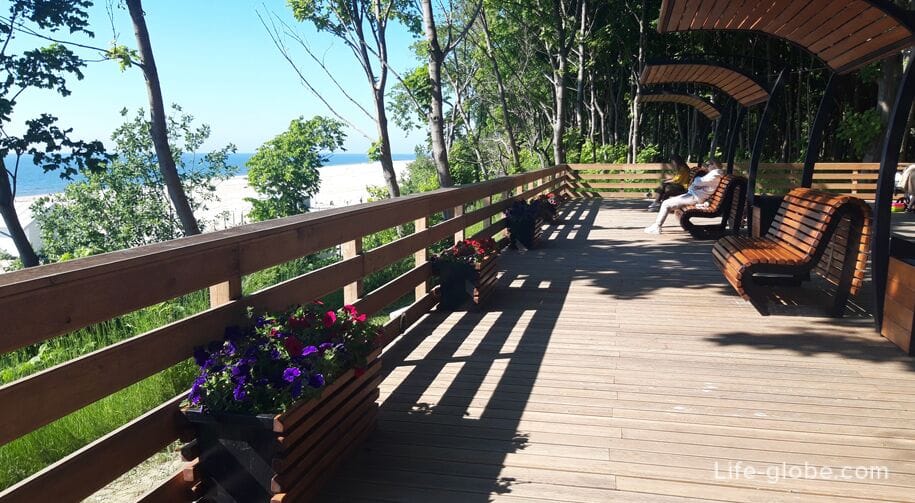
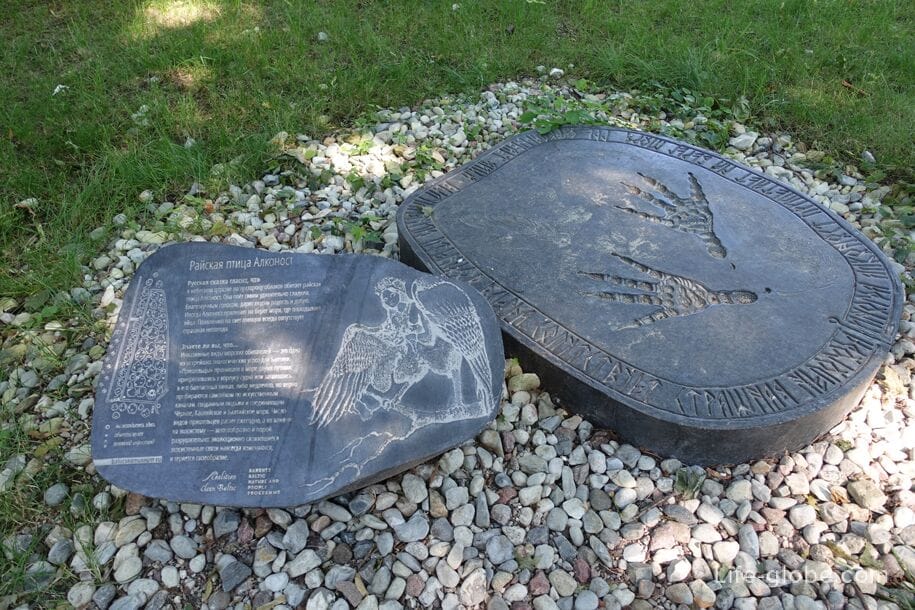
Current The 5-star Schloss Hotel, which is considered the best in Amber and is located near the Central Beach surrounded by Becker Park, has historical roots - a former hunting castle.
The hunting castle was built in the 17th century by Elector Georg Wilhelm, who was fascinated by the Palmniken of East Prussia (now the village of Yantarny), around which there were rich hunting grounds.
In 1703, the new owner, the first Prussian King Frederick I expanded and enlarged the hunting castle.
In the 19th century, Moritz Becker acquired the estate and surrounding lands. In 1870, Becker demolished the old building and built a luxurious house on its foundation, called "Schloss" (Schloss).
In 1899, the Becker house became the property of the Prussian state and was used as a hotel for numerous vacationers from different cities of Germany. Since that time, the house has been called "Schloss-Hotel" ("Schloss-Hotel"), which means "Castle-hotel".
During the Second World War, the building survived. Later, it housed first the library, and then the restaurant "Amber Coast".
In 2012, the new owner restored the historical part of the Schloss Hotel according to old drawings and photographs in the form in which it was built by Maurice Becker. Then a modern building was additionally erected on the territory of the hotel.
The hotel features: free Wi-Fi, spa center, sauna, fitness center, indoor pool with hot tub, terrace, restaurant and 24-hour lobby bar with fireplace. Breakfast is included in the room rate. Link to the hotel
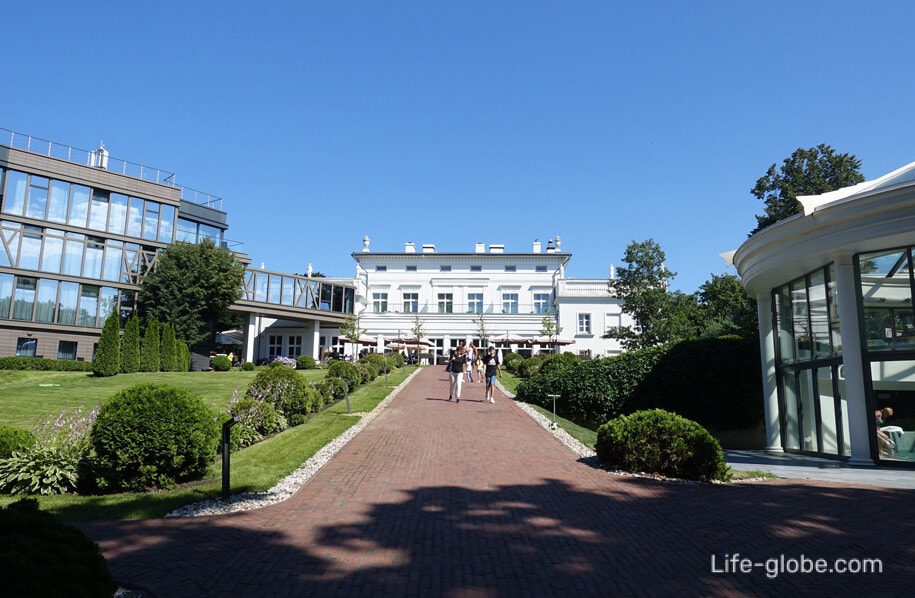
Masters Square is the central and most attractive square in Amber.
This small and cozy square got its name in 2007 in honor of the masters of jewelry, who in different periods of time devoted their talents, creative forces, time and love to amber.
On Masters Square there are: a vintage-style trade and exhibition complex; cafes and eateries; places to relax; retail outlets, which, among other things, sell amber products and amber cosmetics.
Address of Masters Square: 72 Sovetskaya Street. Learn more about Masters Square...
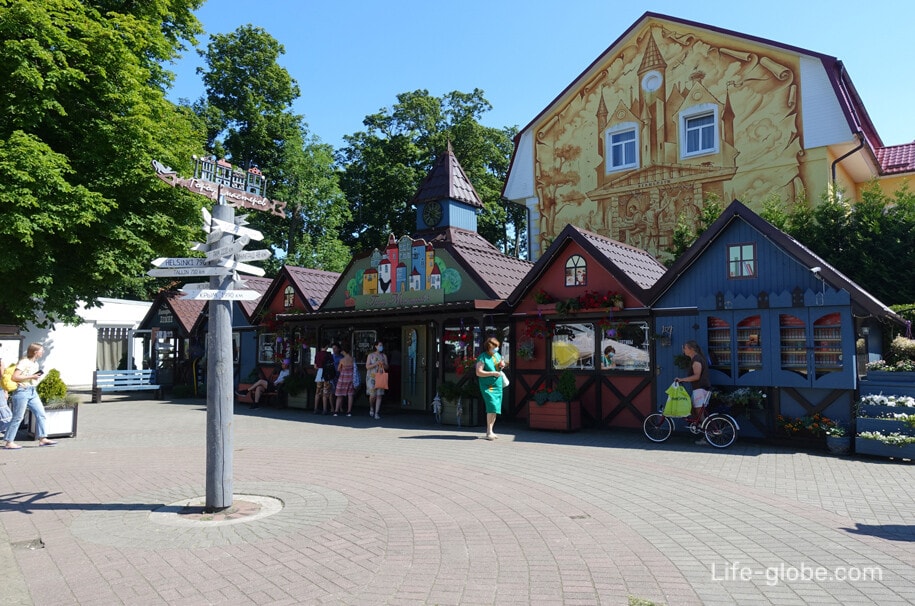
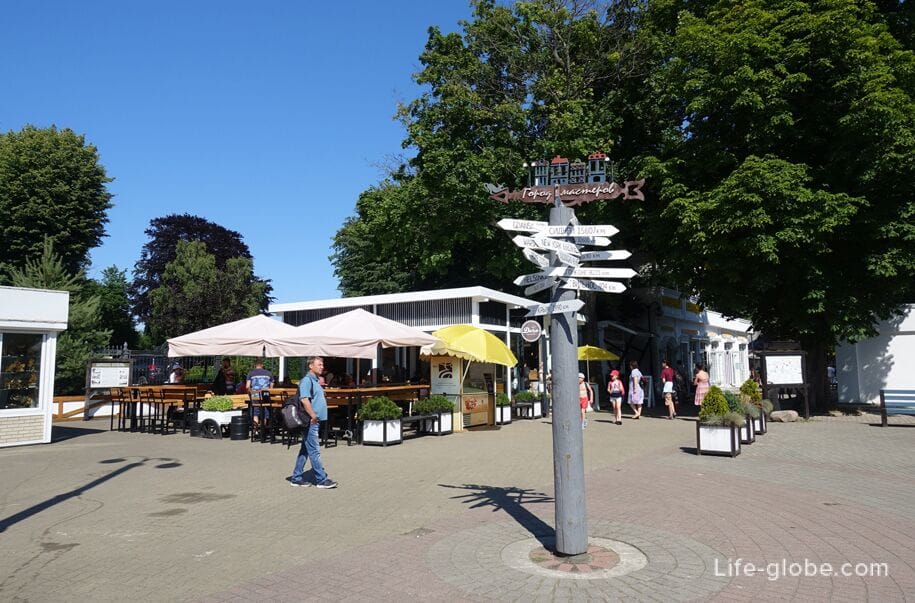
A small and well-groomed Park Square, marked by the so-called "Amber Way", is located between the northern part of Becker Park and Sovetskaya Street.
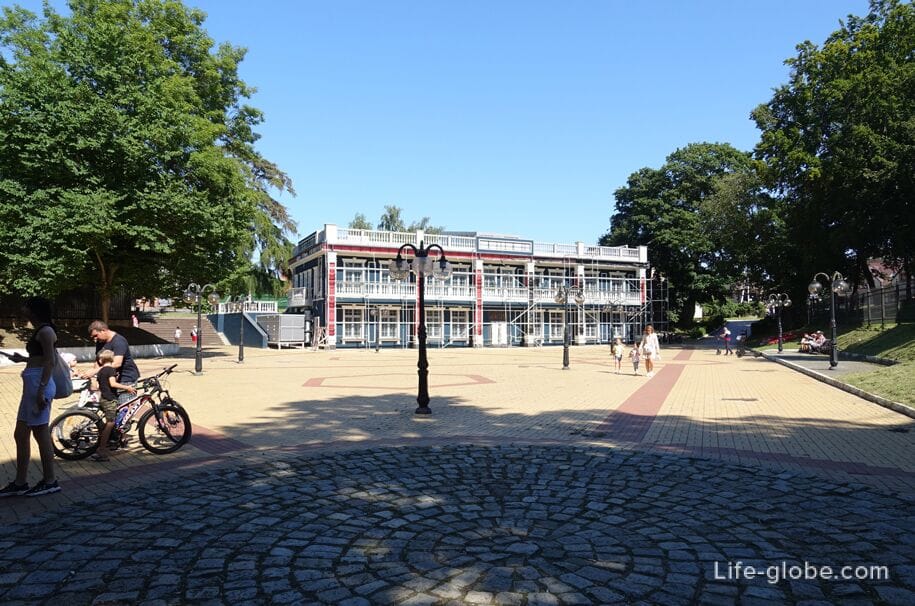
The Church of the Kazan Icon of the Mother of God is an Orthodox church, which is the main shrine of the village of Yantarny.
The current and restored church was originally the Palmniken Lutheran Church, founded on September 8, 1887 on the initiative of the amber mining entrepreneur Moritz Becker. The church was built of boulders and shaped bricks and was a smaller copy of the Chapel of St. George of the royal castle of Montbijou on the outskirts of Berlin.
After the Second World War, in the walls of the former church, already by that time, at various times there were: a club, a billiard room, a sports hall and a warehouse.
In 1990, the church building was transferred to the Russian Orthodox Church, then restored. On January 13, 1991, the shrine was consecrated as a temple of the Kazan Icon of the Mother of God.
The address of the temple: Sovetskaya Street, 67A. More about the Church of the Kazan Icon of the Mother of God...
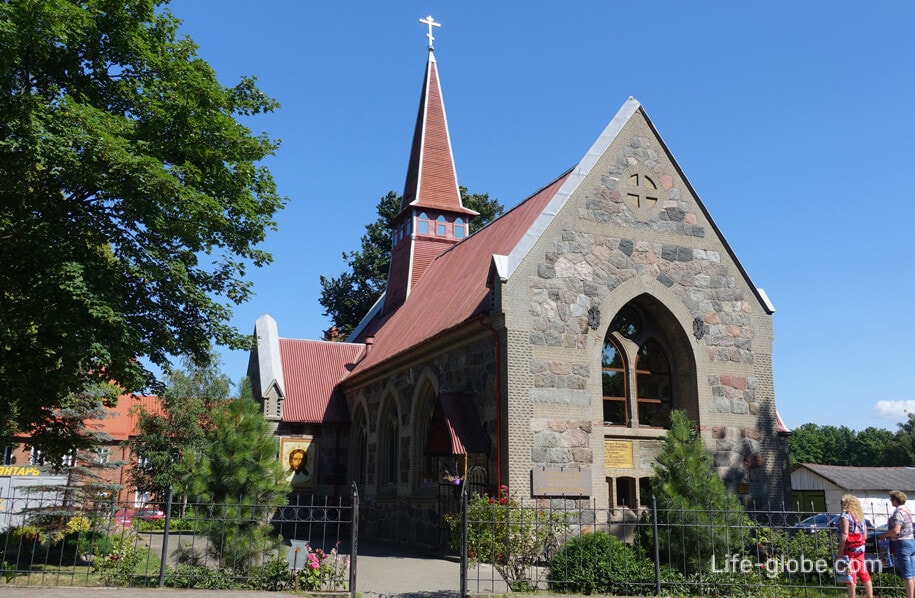

The single-domed Orthodox Chapel of St. Nicholas the Wonderworker, commonly called the St. Nicholas Chapel, is located in the old cemetery of Yantarny.
The chapel is served by the clergy of the Church of the Kazan Icon of the Mother of God in Yantarny.
Address: landmark - Dachnaya Street, 10b.Coordinates: 54.859527°N 19.947313°E.
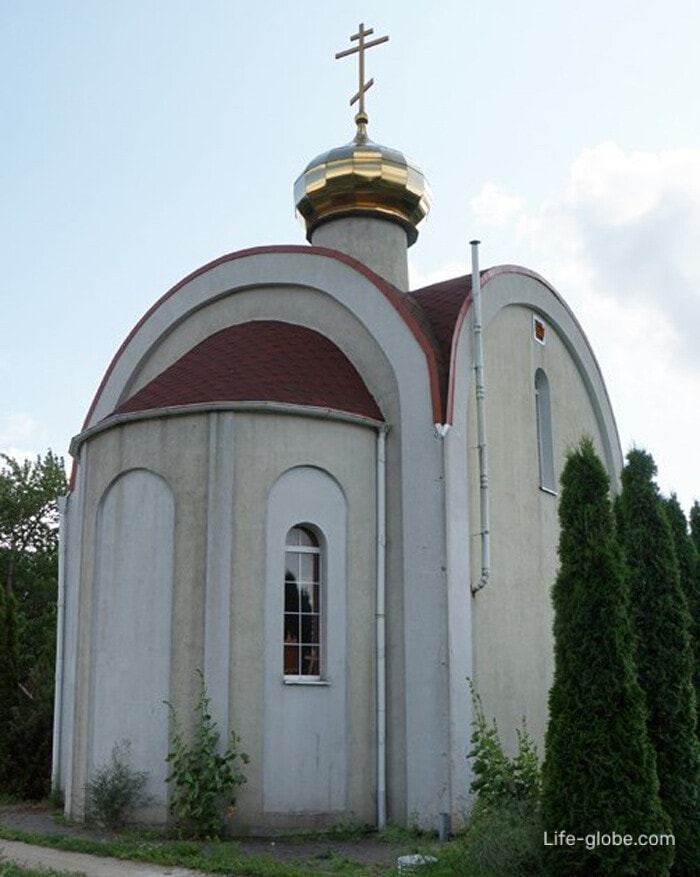
The entrance sign "Virgin of the Baltic", also known as the "Mermaid composition", is an entrance sign in the form of a mermaid composition in sea waters, installed at the southern entrance to Yantarny (from the city of Kaliningrad) - Sovetskaya Street.
The sign is one of the symbols of the village, and its part is depicted on souvenirs and postcards.
The sign was built in 1998 by the art cooperative "Victoria". Subsequently, restoration work was carried out.
A local legend is associated with this sign, which tells about the love of a fisherman and a mermaid - the daughter of the ruler of the sea waters of Triton. Having learned about the love of his beloved daughter for an ordinary fisherman, the lord of the water elements became enraged and killed the fisherman. The mermaid wept bitterly until her tears became amber pebbles, exactly those that were carried ashore by the waves and found by the villagers and vacationers on the coast.
Coordinates: 54°51'20"N (54.855788), 19°56'59"E (19.949791).
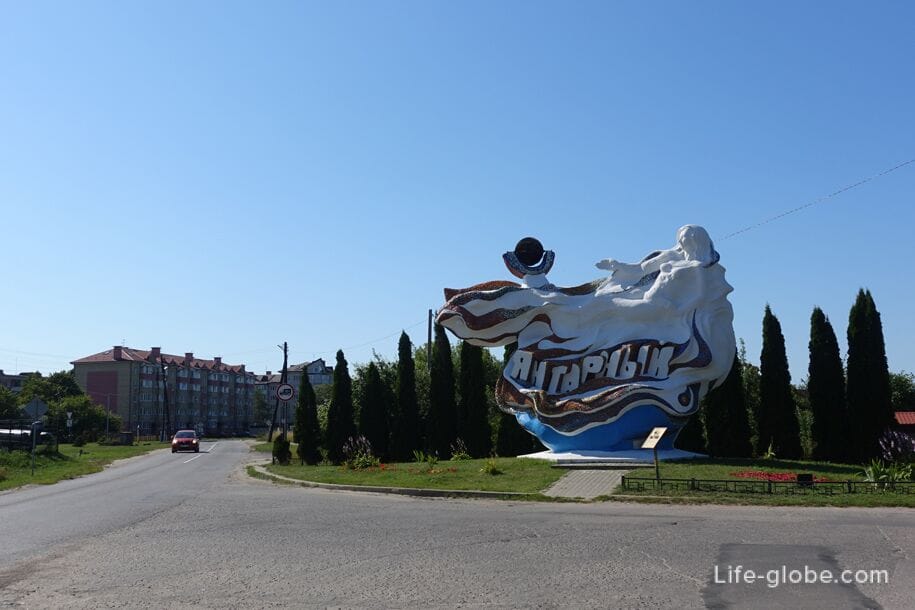
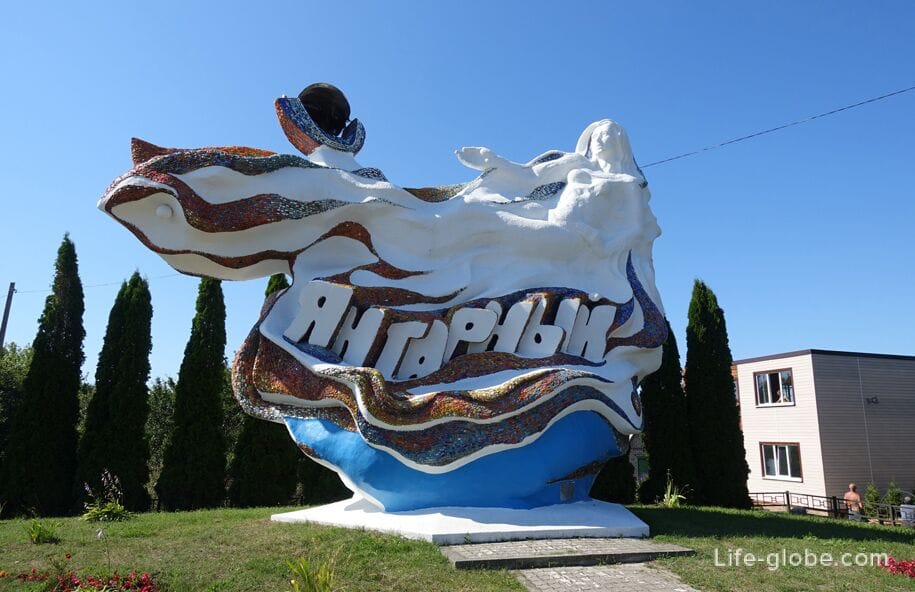
Opposite the entrance sign "Virgin of the Baltic" there is another memorial stone, which was installed at the entrance to Yantarny not so long ago.
There is an inscription on the stone: "Palmnicken → Aquileia 1067 Miles". Palmniken is now the village of Yantarny; Aquileia is a city in the northern part of Italy, which in ancient times was an important trading post, a large and famous city founded by the Romans in 183-181 BC; 1067 miles is the distance from Yantarny to Aquileia.
The Amber Way is an ancient trade route, the point of delivery of raw stone (amber) along which was the city of the Roman Empire - Aquileia.
The amber trade in the Kaliningrad Region began at the end of the Stone Age, and its heyday dates back to the era of Roman domination. In Viking times and later, amber was one of the main commodities in the Baltic. In exchange for amber, the Prussian nobility received imported items from Ancient Russia and Europe. After the conquest of the Prussian lands at the end of the 13th century, the Teutonic Order monopolized the trade and extraction of amber, founding the Amber Department. During the Renaissance and Baroque periods, there was a surge of interest in amber in Konigsberg. In the 19th century, commercial amber mining began on Sambia and the Curonian Spit.
The project "Amber Way. From the Baltic to Aquileia" has been organized since 2016, dedicated to the actualization of the history of amber in the Kaliningrad region and is a tourist route combining points on the map (places), one way or another connected with the history of the sunstone.
Now there are attempts to extend the route outside the Kaliningrad region, including in Lithuania.
Points and places of the Amber way tourist route can be specified on the website: amberroute.
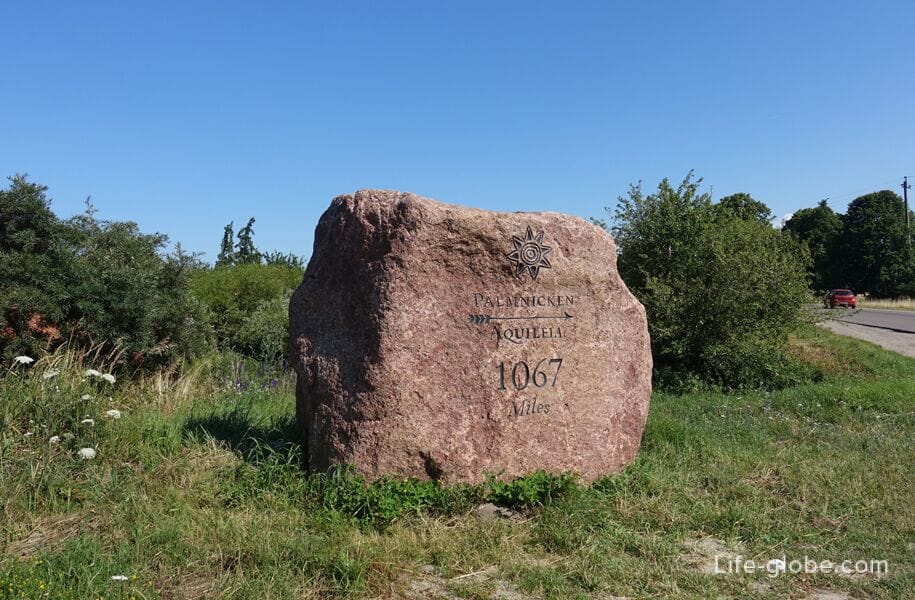
The observation deck of the existing Primorsky open-pit amber quarry is a unique tourist attraction, since visitors to the site, located at an altitude of more than 50 meters, can observe in real time the work in the amber quarry - the only place in the world where amber is extracted on an industrial scale by open-pit mining.
Lookout career is part of the complex under the open sky, which includes, in addition to the observation, the following tourist facilities: landscaped area; the pavilion dining, shopping hall and WC; observation tower; "the Amber pyramid"; "amber tree"; attraction "the amber"; the layout of the entrance to "Mine Anne"; layout of "Hangman" and some of the equipment for mining.
The complex of the observation deck of the Primorsky quarry is located just south-east of the village of Yantarny. Coordinates: 54°51'43" (54.861992) S.sh., 19°58'19" (19.972205) V.D.
Entrance to the observation complex is paid. Website: ambercombine. Learn more about the complex of the observation deck of the Primorsky quarry...

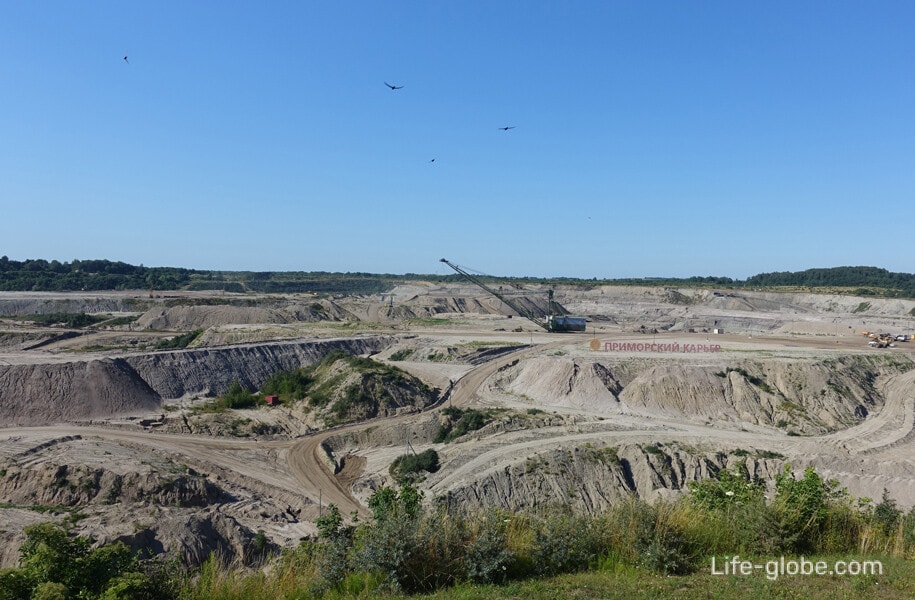
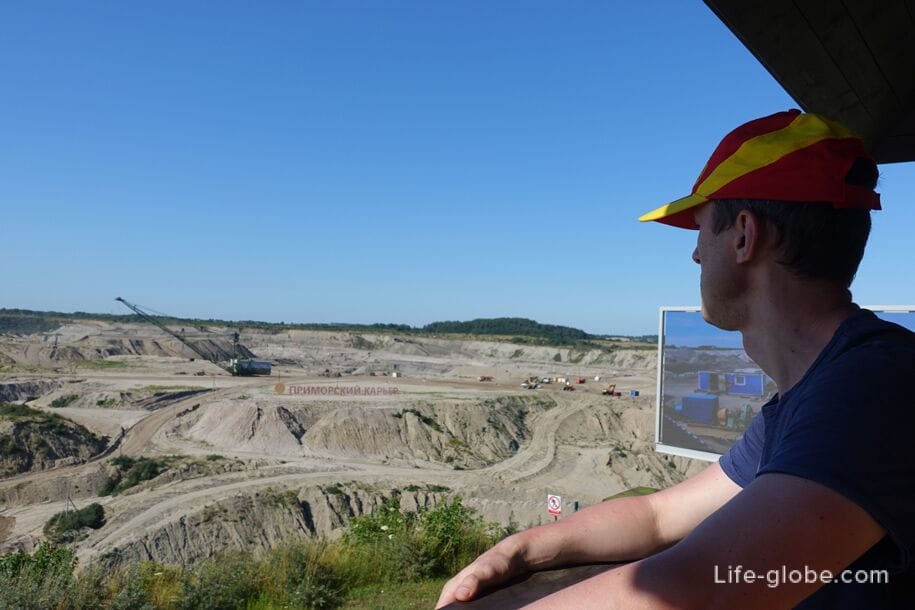
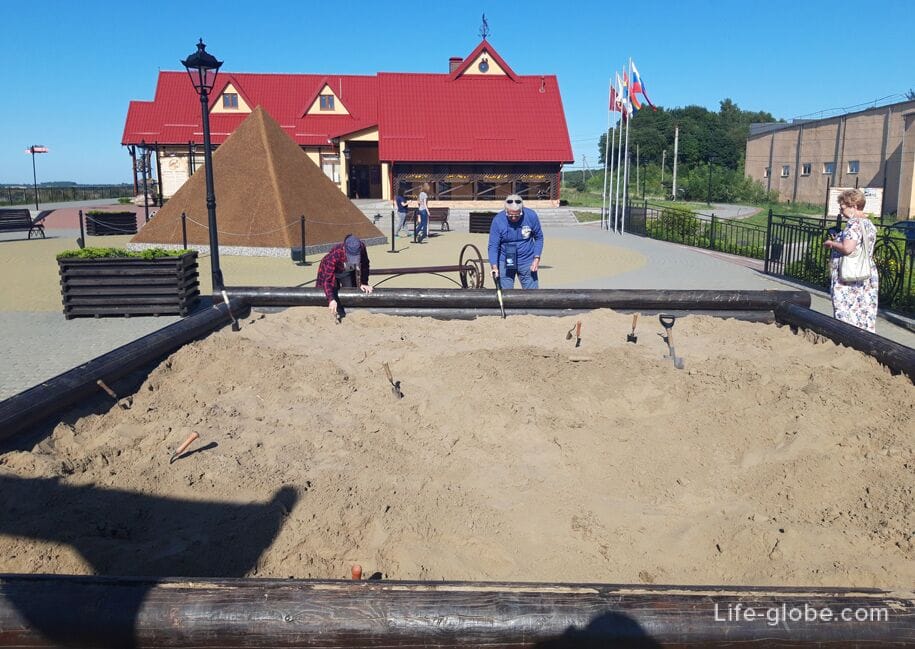

The ceramic model "Palmniken of the end of the XIX century" was installed in Yantarny in 2018, created by a creative group of residents of Yantarny, Sinyavino and Kaliningrad with the support of Yantarnaya Laguna LLC.
The layout shows Palmniken at the end of the 19th century. The highlight of the layout is the amber trees made by Svetlana Eliseenko.
The layout is located in the courtyard of the Amber Lagoon store, located at 63 Sovetskaya Street.Coordinates: 54°52'7"N (54.868627), 19°56'20"E (19.939078).


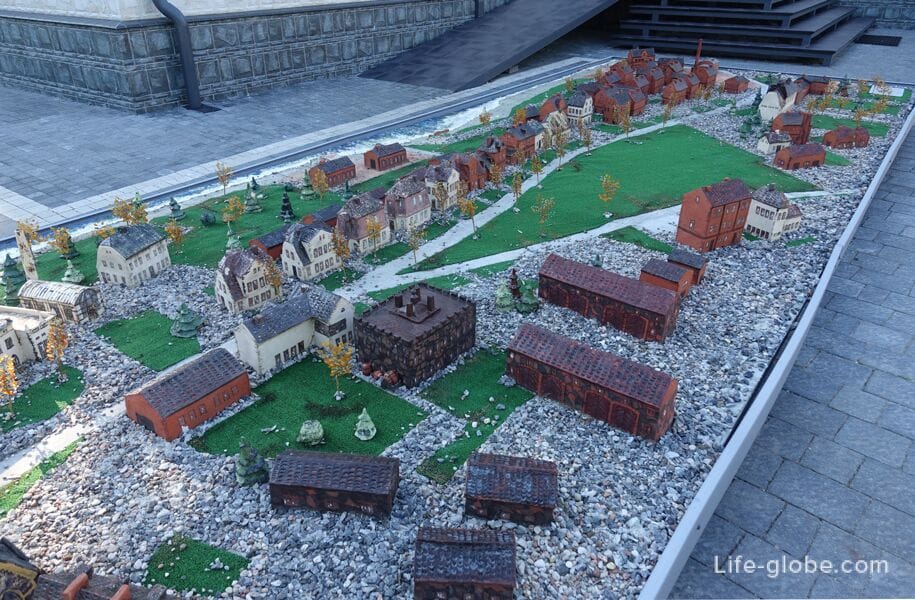

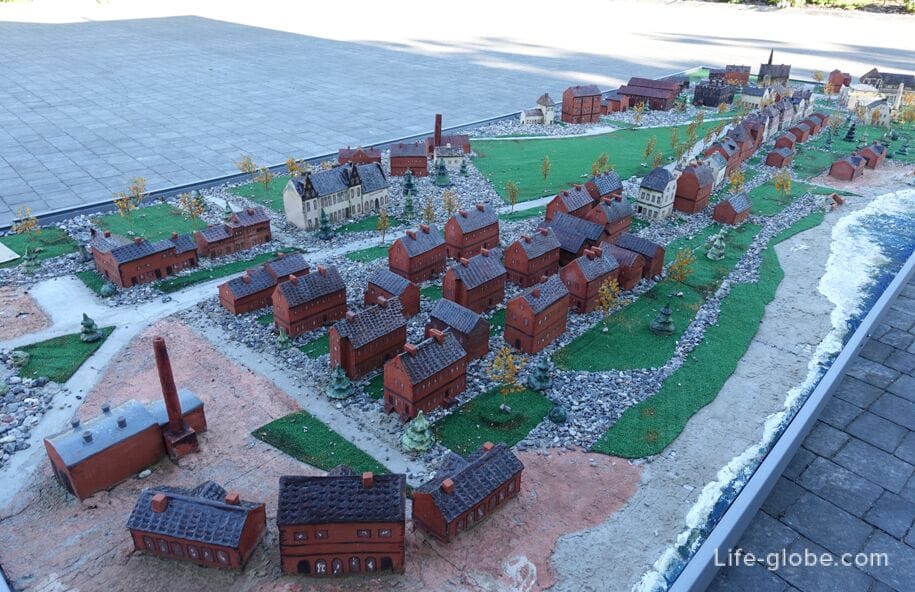
The Amber Castle Museum and Exhibition Complex, opened to the public in 2007, has ancient roots.
According to available data, the museum and exhibition complex is located on the site of a former building that was once part of the Palmniken fortress.
The museum's expositions are based on a narrative about the history of Palmniken-Yantarny and amber crafts - from the origin of amber deposits to its extraction and processing.
In addition to the expositions, the museum has an interactive hall where visitors can observe the processing of amber in existing workshops and try to make something for themselves.
There is also a shop in the museum; temporary (rotating) author's exhibitions of artists are held; creative evenings; concerts of bard and chamber music; amber auctions are arranged.
The museum's address is 61a Sovetskaya Street.Coordinates: 54°52'8"N (54.868943), 19°56'22"E (19.939517). Website: amber-castle-amber. More about the Amber Castle Museum...
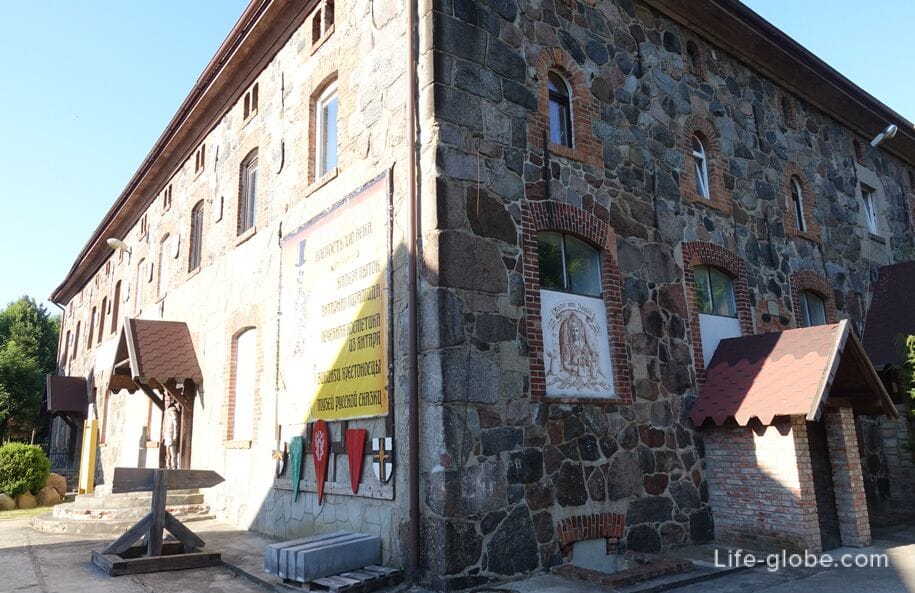
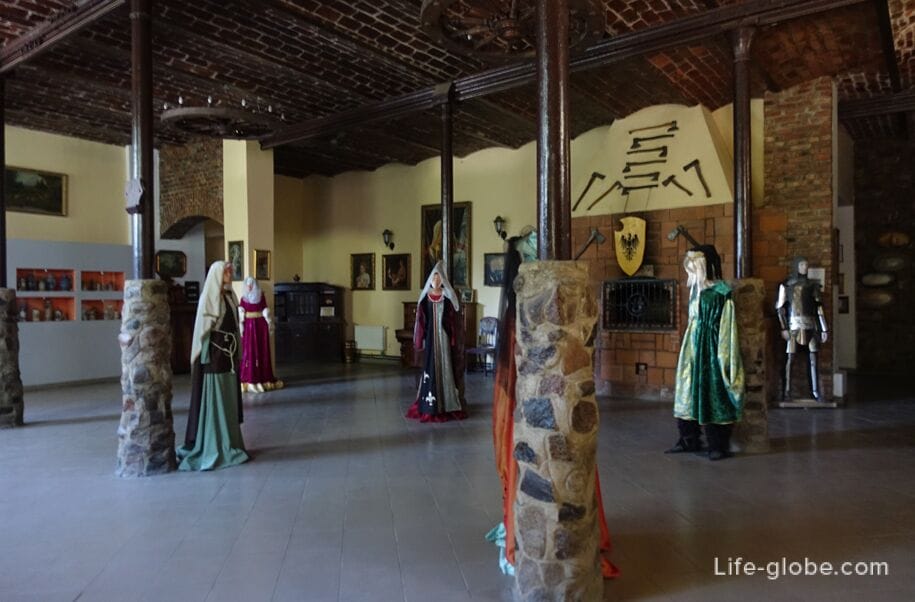
Behind the museum building, on its eastern side, are probably the former stables and carriage house of the Palmniken estate.

The Museum of the Amber Combine is an interactive exhibition hall called the Amber Chamber.
The exposition of the museum, located on the ground floor of the building of the restored former Tool shop of the Kaliningrad Amber Combine, tells about the history and industrial activity of the combine, and also shows the amber collection of the enterprise.
In addition, the hall is equipped with a special photo zone where you can sit on the "Amber Throne", try on an amber tiara and amber beads, while taking individual photos for memory.
In addition to the exhibition, the museum also functions as a retail space where guests can buy amber souvenirs, gifts and jewelry with amber and amber.
Museum address: 1 Balebina Street (entrance from Zheleznodorozhnaya Street). Website: ambercombine. More about the Amber Factory Museum...
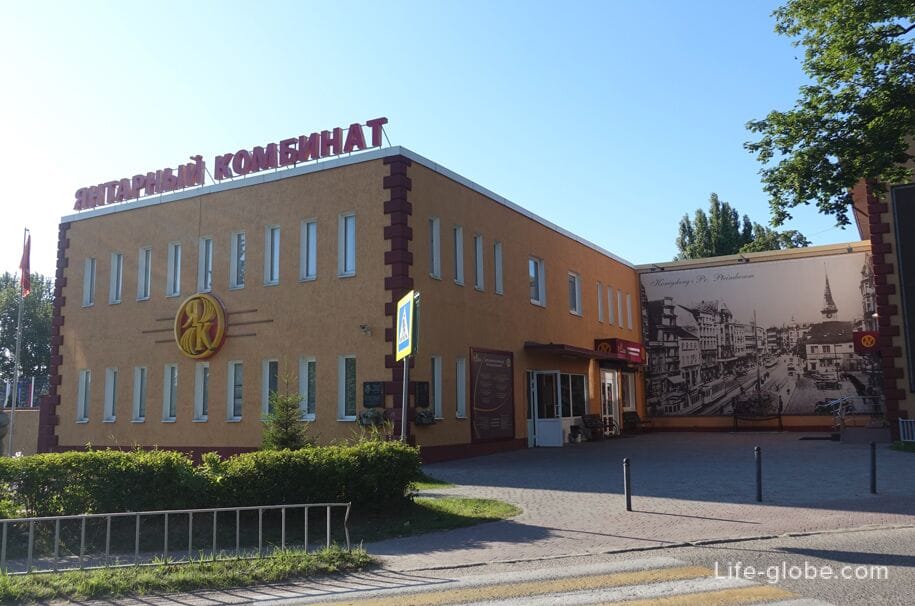
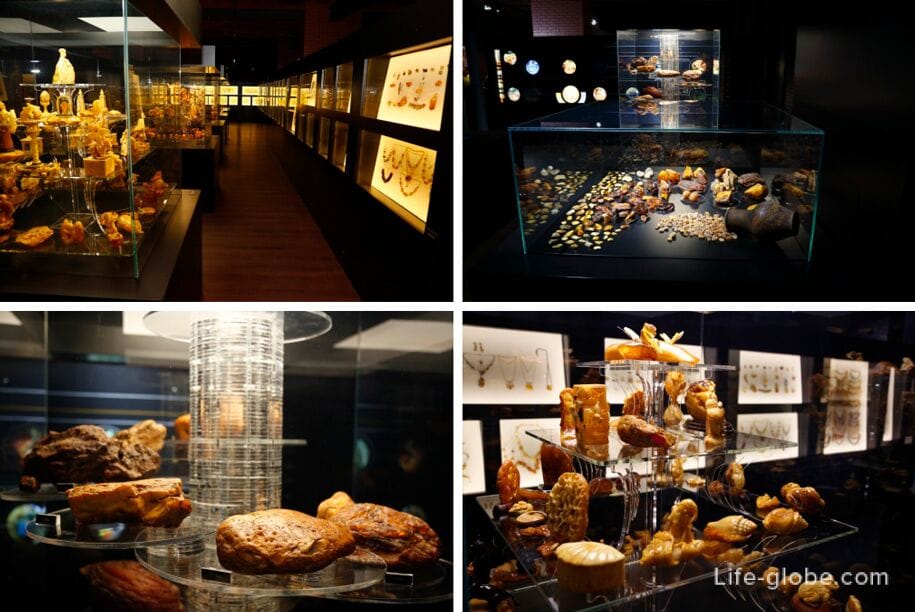

Memorial plaques are placed on two corners of the museum building (east and south):
- memorial plaque to the director of the Kaliningrad Amber Combine in 1964-1987 - Vasily Nikolaevich Rozhkov (1924-2003).
The inscription on the memorial plaque: "Vasily Nikolaevich Rozhkov (1924-2003). Director of the Kaliningrad Amber Combine from 1964 to 1987. Participant of the Great Patriotic War and the Victory Parade of 1945 in Moscow. The first Honorary citizen of the Amber City District";
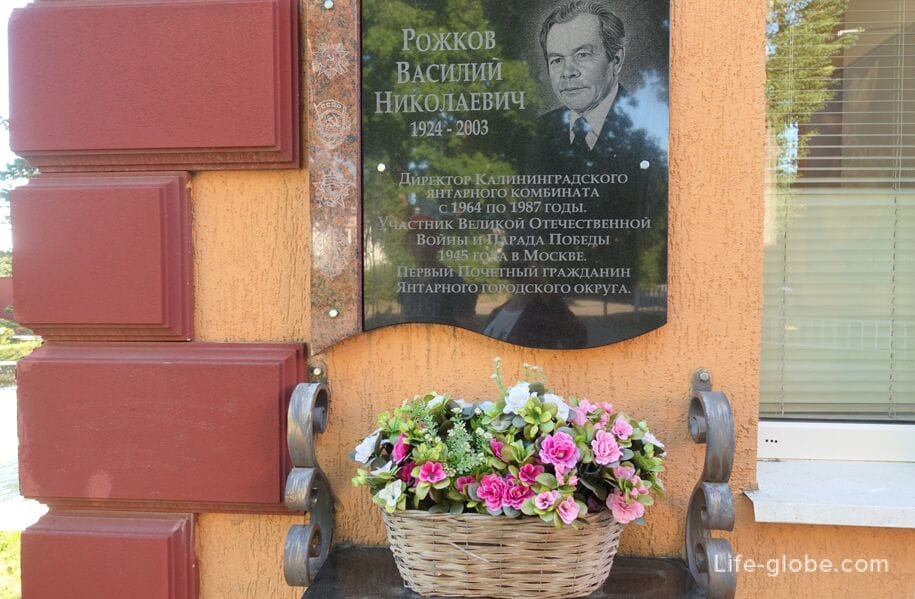
- memorial plaque to the Hero of Socialist Labor, director of the Kaliningrad Amber Combine in 1955-1962 - Rizaev Kerim Novruz oglu (1914-1995).
The inscription on the memorial plaque: "Rizaev Kerim Navruzovich (1914-1996). Hero of Socialist Labor, veteran of the Great Patriotic War, participant in the storming of Konigsberg, director of the Amber Plant since 1959. He lived and worked in Yantarny from 1945 to 1962."

Near the southern wall of the museum building there is a fountain with a sculpture of a girl.
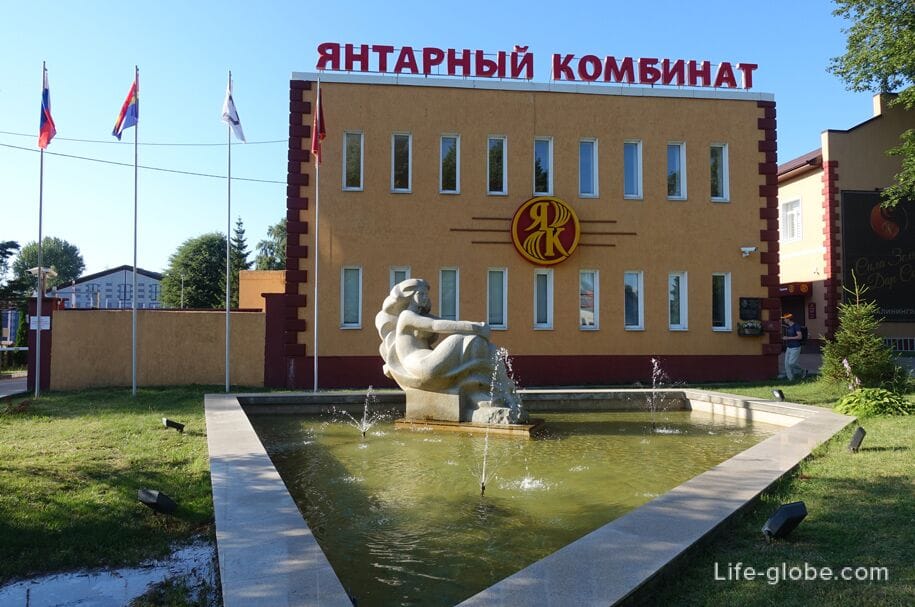
The water tower was built in 1920 in Palmniken. For this reason, the tower is called the "Palmniken water tower".
The tower has a height of 35 meters and a diameter of 11 meters.
During the overhaul of the roof and facade of the tower in 2006 - 2007, a weather vane in the shape of a unicorn was installed on the tower.
Currently, the water tower operates for its intended purpose.
The address of the tower: 3 Zheleznodorozhnaya Street.Coordinates: 54°52'14"N (54.870771), 19°56'29"E (19.941602). Learn more about the water tower...
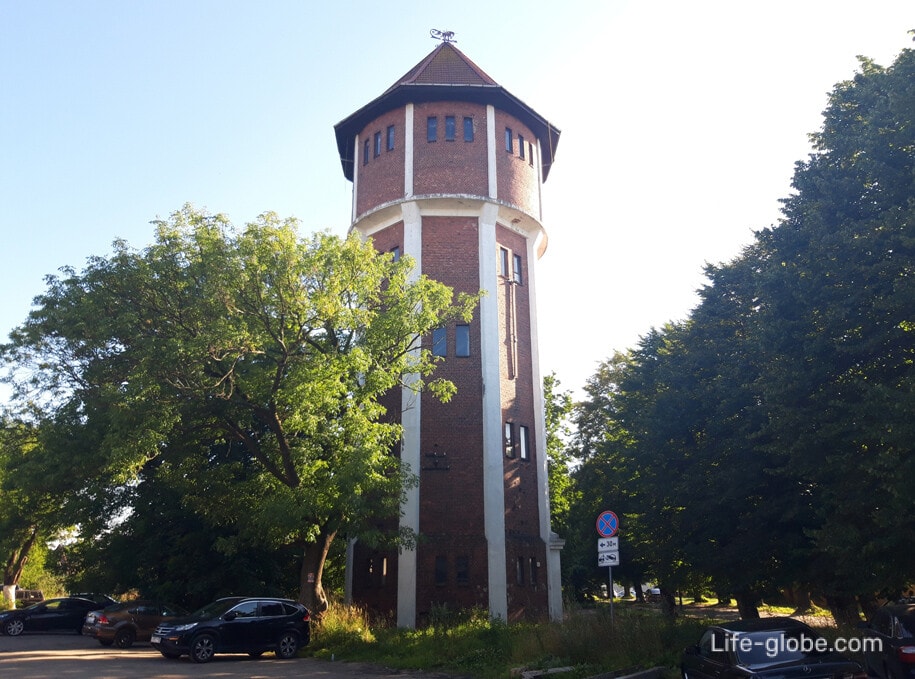

Once there was a railway line in Palmniken, which was laid in the 1880s from Fischhausen (now the city of Primorsk, Kaliningrad region) and there was a railway station.
Today there are no railway tracks, and the old station building (restored) is located at 5 Zheleznodorozhnaya Street.
Coordinates: 54°52'15"N (54.870999), 19°56'32"E (19.942394).
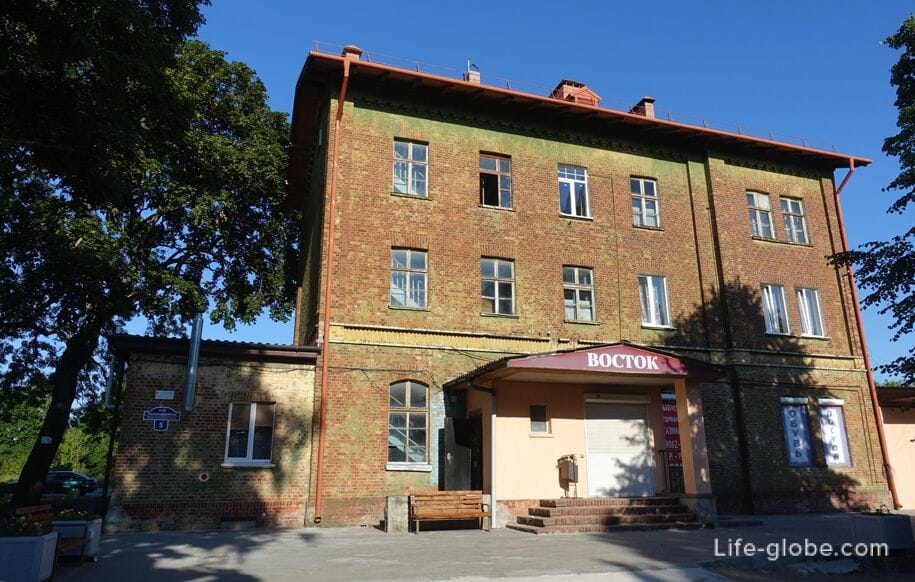
Pre-war photo: water tower (left), railway tracks and station building (right).
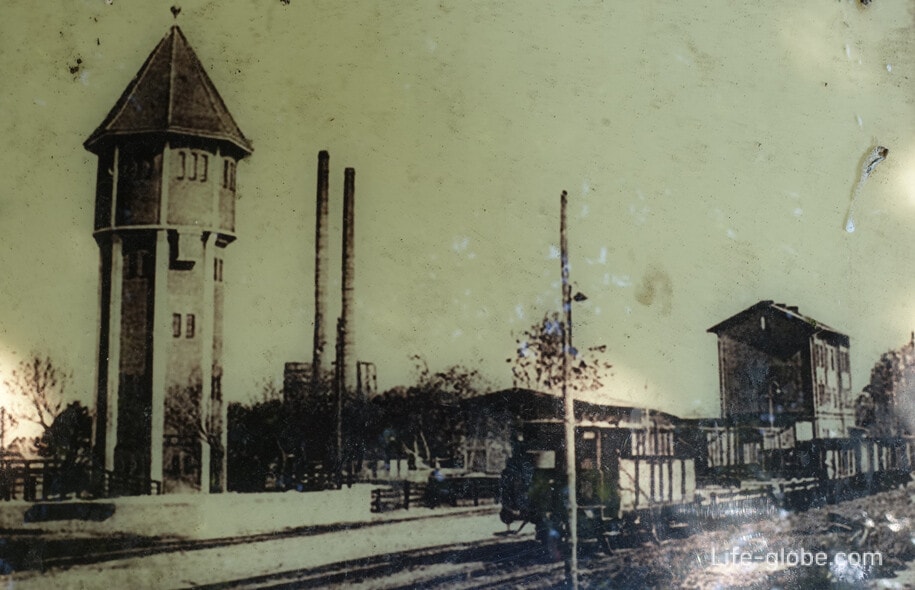
The mass grave of Soviet soldiers who died in April 1945 was formed during the fighting. More than 50 people are buried in it.
The monument was erected in 1950. Subsequently, repair and restoration work was carried out.
In 2006, a symbolic reburial of unknown pilots who died in the vicinity of Palmniken was moved to a mass grave - a two-seater aircraft, presumably of American production, was found in the quarry area, the remains of the pilots were not found.
The main object of the mass grave complex is a 4-meter metal sculpture depicting a soldier with his left hand raised and a machine gun in his right. The sculpture is located against a vertical wall.
The address of the mass grave: Sovetskaya Street, 60 (intersection of Sovetskaya and Zheleznodorozhnaya streets). Coordinates: 54°52'10"N (54.869450), 19°56'19"E (19.938868).
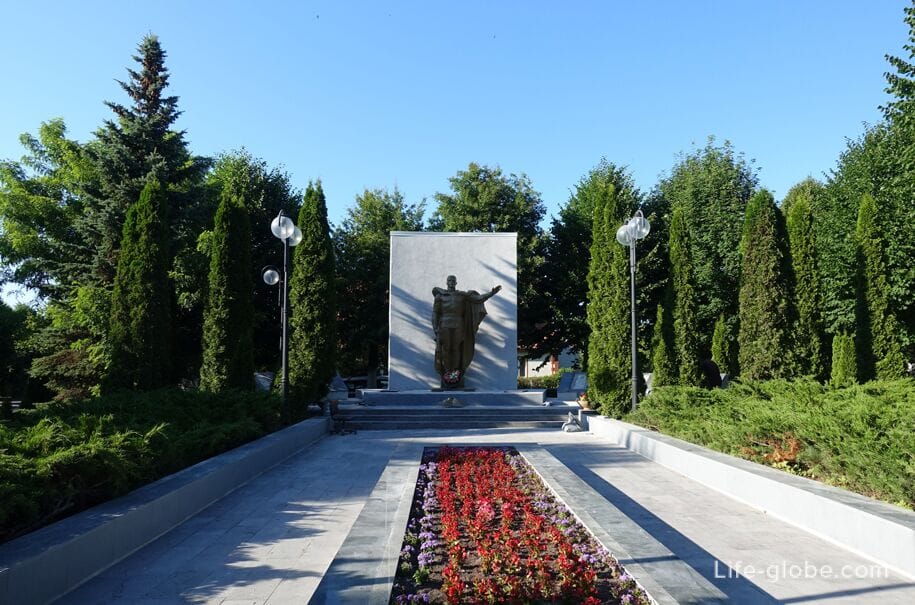
A stone pedestrian bridge was built in Palmniken on the embankment of the former branch of the Anna Mine quarry railway for the extraction of amber in a closed way.
The remains of the bridge have now been restored, the railway tracks have been dismantled.
The bridge is located on Sovetskaya Street. Coordinates: 54°52'37"N (54.877091), 19°56'16"E (19.937917).
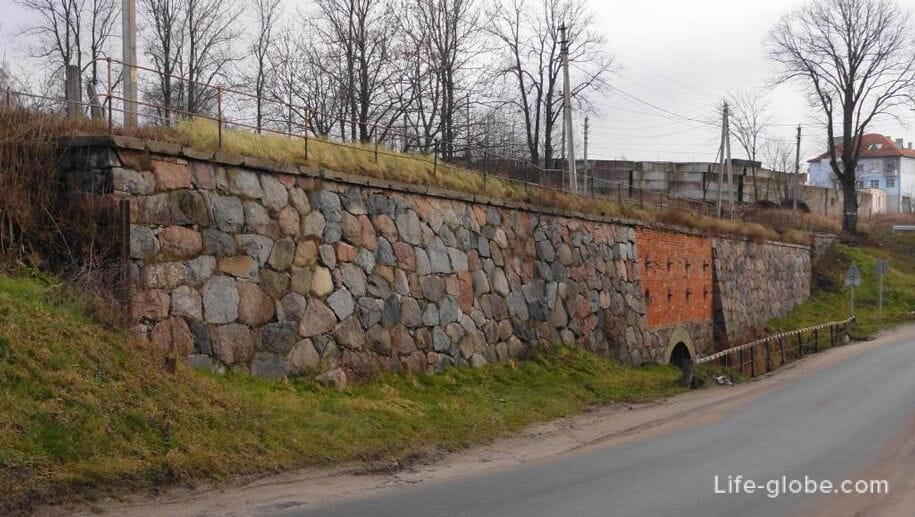
The museum "Root Sculpture" - surrealism in the style of Salvador Dali, is a private small museum, which presents surrealistic sculptures from tree roots made by the artist Alexander Savelyev.
"I gave the museum the name "Salvador Dali Museum" because the work of this artist inspires me" - the words of the author of the sculptures Alexander Savelyev.
The exposition is located on the first floor of the old German stable. On the second floor there is a sculptor's workshop and a living space. In total, Alexander Saveliev presents about 60 of his works created in different years.
Museum address: 1a Lermontov Street.
Attention! The museum is private, so it can close and (or) move at any time.
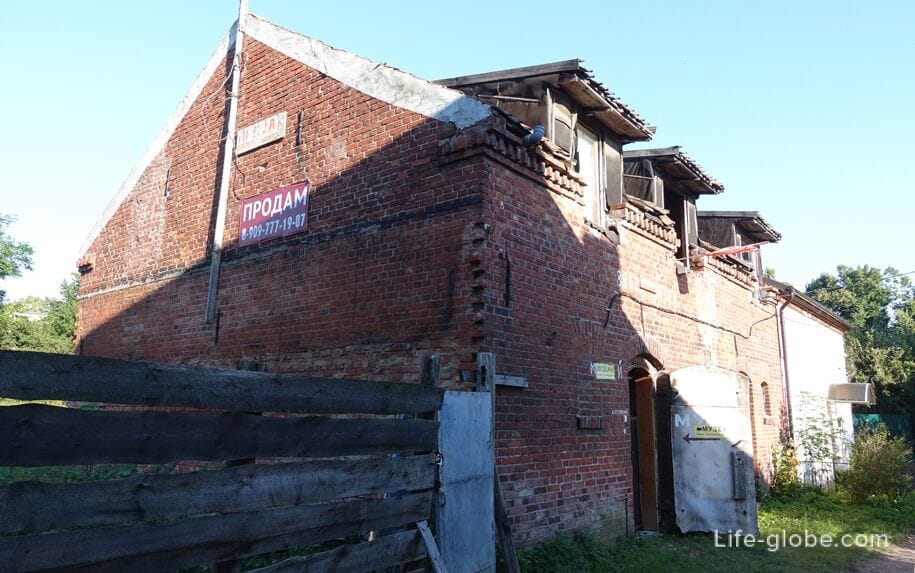
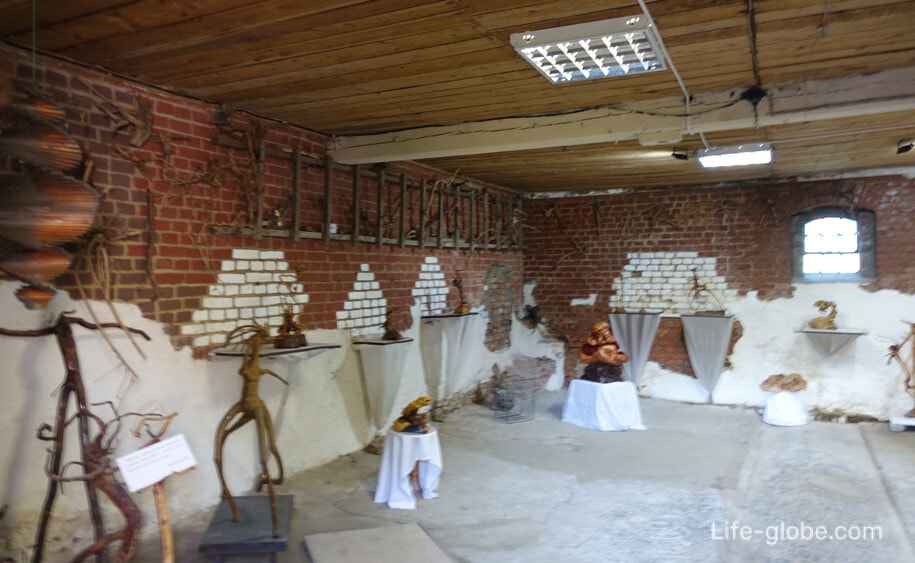
The monument to the victims of the Holocaust is a memorial to the victims of the "Death March", which was opened on January 30, 2011.
The monument is designed to remind and never forget about the tragedy that became the last act of the Holocaust in East Prussia and occurred in January 1945, when several thousand people were shot on the shores of the Baltic Sea, who were brought to Palmniken from the ghettos and concentration camps of East Prussia.
The monument is set on a two-tiered base, carved from granite, seven-meter-high three arms raised to the sky, on which are the numbers of concentration camp prisoners.
"They are pulling their hands up out of the water in search of salvation, help, which did not come at that moment," explains the idea of one of the authors of the project - Frank Meisler.

A little to the north of the monument there is a memorial sign - a small pyramid installed earlier than the main monument.
The pyramid is made of field stones, on which is a memorial plaque with the inscription: "In memory of the 7000 victims of the Holocaust killed by the Nazis on January 31, 1945 ..." and a plaque: "The memorial was installed at the expense of the Jewish Community of Kaliningrad ...".

The monument to the victims of the Holocaust and the memorial sign are located near the northern outskirts of the village of Yantarny, near the beaches and the sea, between Sovetskaya Street and the coastal strip. Coordinates: 54°53'4"N (54.884650), 19°56'8"E (19.935566). Learn more about the monument to the victims of the Holocaust and the memorial sign...
The Anna mine is the former Anna amber mining mine, which was founded in 1883 in the village of Pilmniken.
Since 1922, due to unprofitability, work began on the conservation of the mine, and soon the production was closed.
Currently, only small remnants of the Anna mine have been preserved, including the remains of the Anna mine retaining wall, above which the Anna Mine observation deck is located.
The observation deck is a small piece of soil.
The site offers panoramic views of the coast, quarries, part of the beach strip, the Baltic Sea and the monument to the victims of the Holocaust.
The observation deck is located near the northern border of the village of Yantarny. The approach is from Sovetskaya Street. More about the observation deck "Anna Mine"...
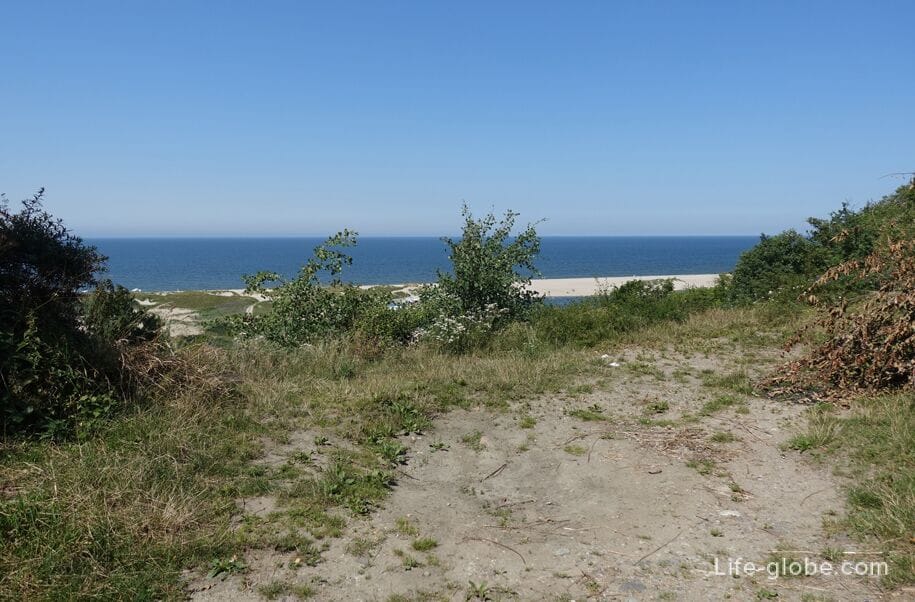
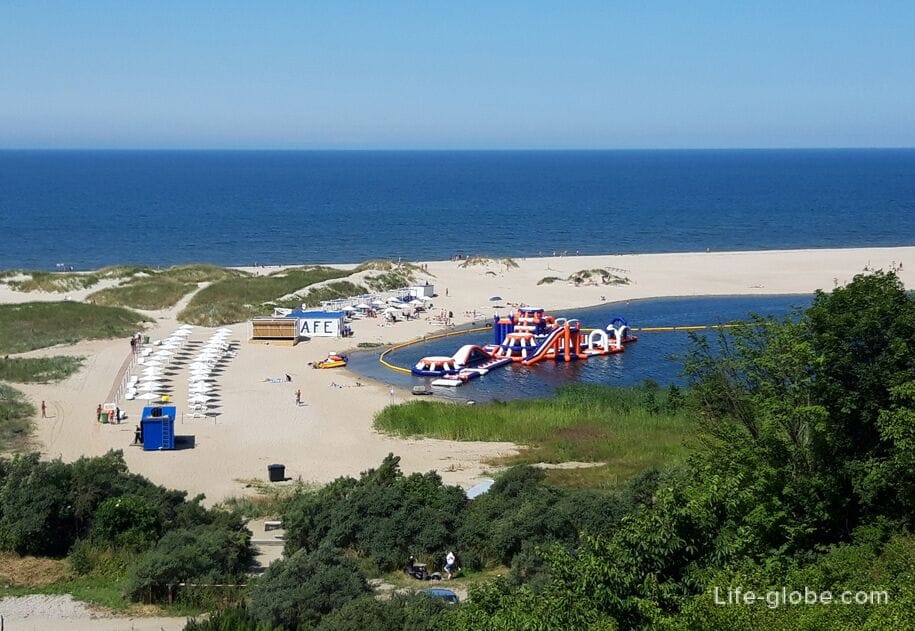
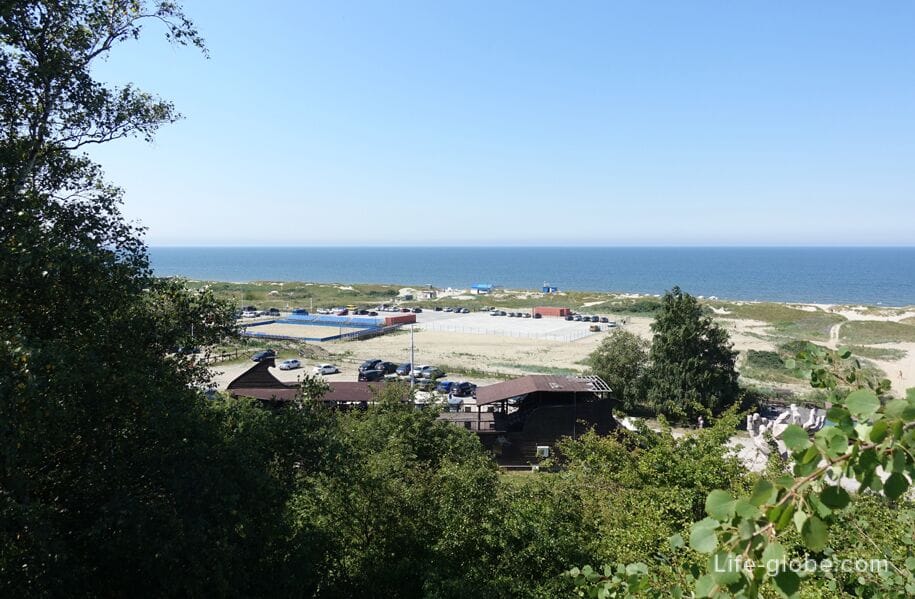
The sculpture "Good Kanta" was made by the artist Vladimir Chilikin, with the money of the deputy of the Regional Duma Alexander Musevich.
Initially, the sculpture was planned to be installed near the entrance to The Cathedral in the city of Kaliningrad, where the philosopher Emmanuel Kant lived at the time of Konigsberg. However, it was criticized by the participants of the regional Council for culture at a meeting in December 2016. After that, the sculpture was installed next to the shopping center "Europe", not far from Victory Square. In November, it was returned to Kant Island, but a few days later they were taken to the back of the Cathedral office on Narva Street.
However, the "rejected migrant" still found his "home" - on November 23, 2017, the "Good Kant" moved to the territory Aquatoria hotel in the village of Yantarny. The sculpture is located here at the present time. Access to the sculpture is open to everyone.
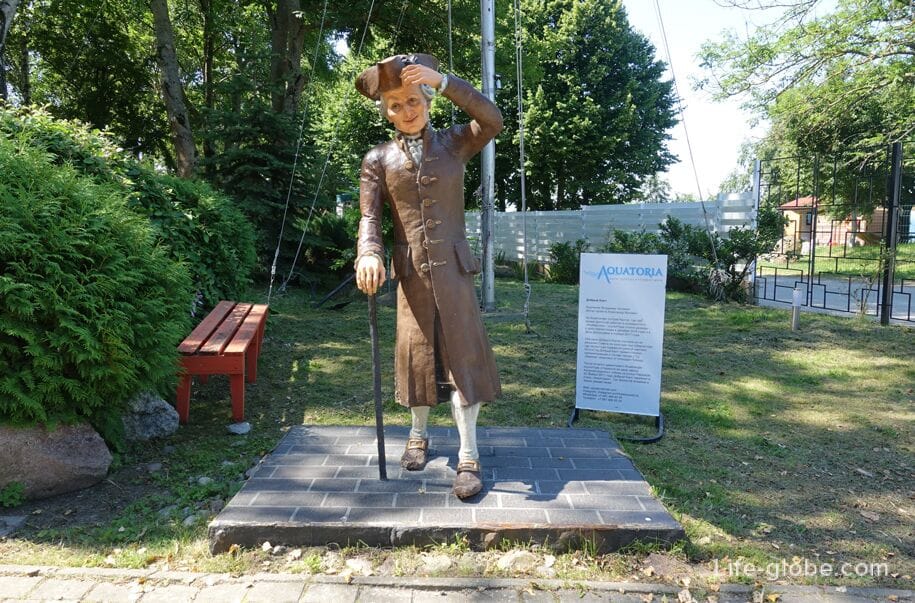
The Aquatoria hotel (Aquatoria camping) is located near the Shakhta Anna beach, at the address: Sovetskaya Street, 1a.
At the hotel: free Wi-Fi, parking, garden, lobby bar, summer restaurant and private descent to the coast.
The hotel has a playground with a view of the coast and the sea, as well as a small area where you can stay in a camping van. Link to the hotel
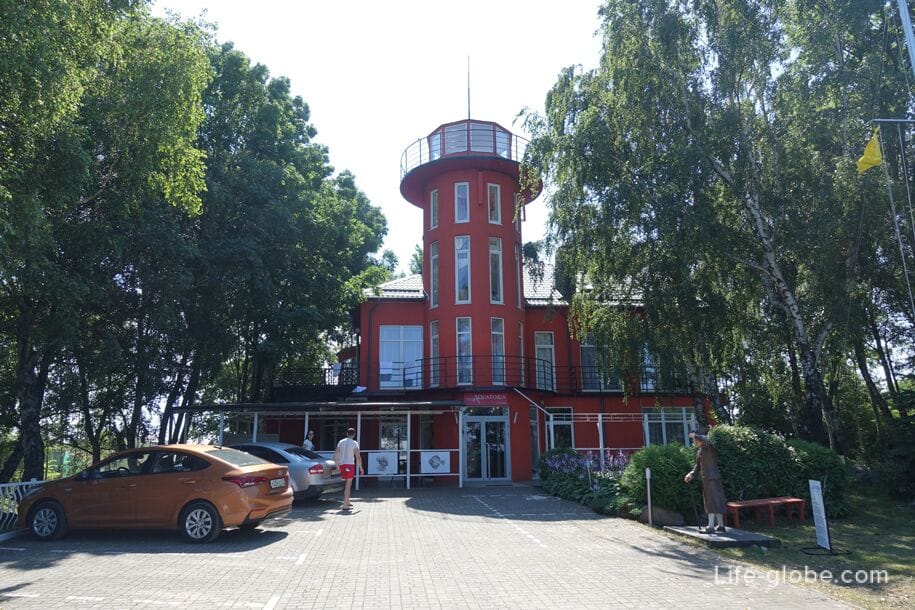
Lake Sinyavinskoye or Amber Lake is a freshwater reservoir that was formed on the site of the former Walter quarry for the extraction of amber.
When the amber-bearing rocks in the quarry were worked out, the quarry was deemed unprofitable and closed, the quarry was filled with spring and groundwater, resulting in the formation of a pond (lake).
Lake Sinyavinskoe is located between the villages of Yantarny and Sinyavino.
The approach to the pond is mainly limited by sufficient steepness and thickets, however, from the village of Yantarny there is a small sandy beach near the lake shore - "Sinyavinsky Lake beach" or "Yantarny Lake beach".
The water in the pond is clear.
Near the lake beach there are: a volleyball court, a recreation center "Pearl" and two diving centers.
Coordinates of Lake Sinyavinsky: 54°53'15.0"N 19°56'54.0"E. More about the beach and lake...


All accommodation facilities in Yantarny, including in the center of the village, as well as near beaches and attractions, can be viewed and booked here